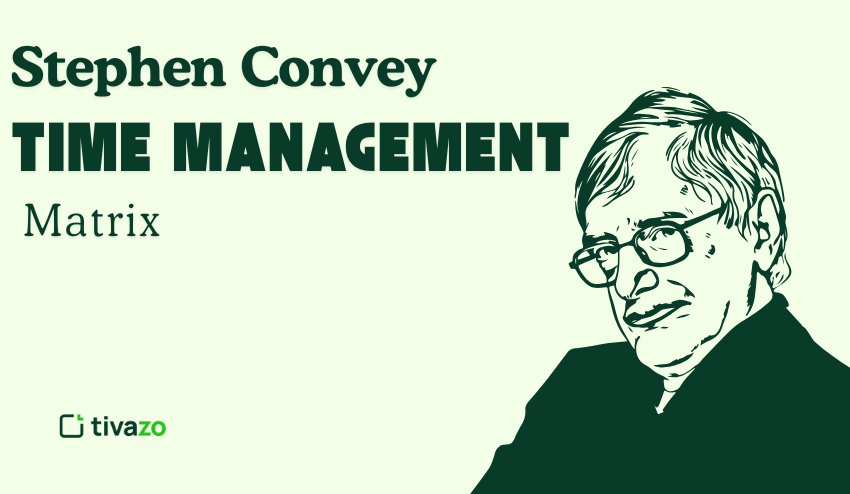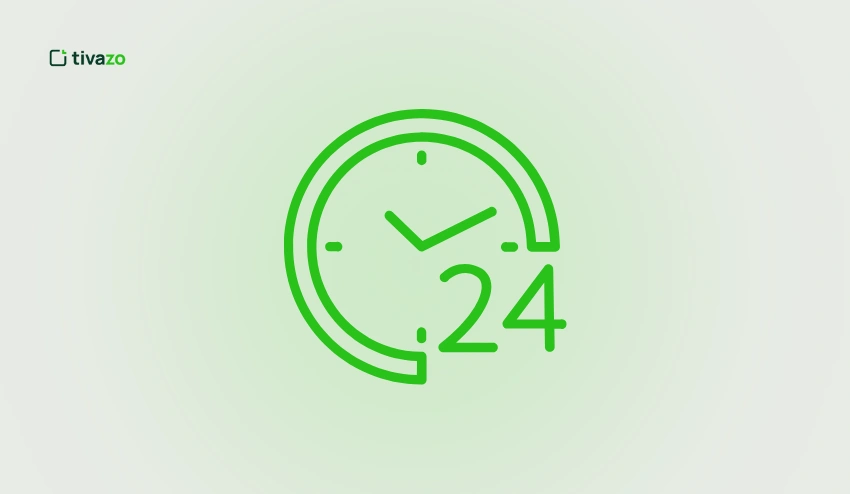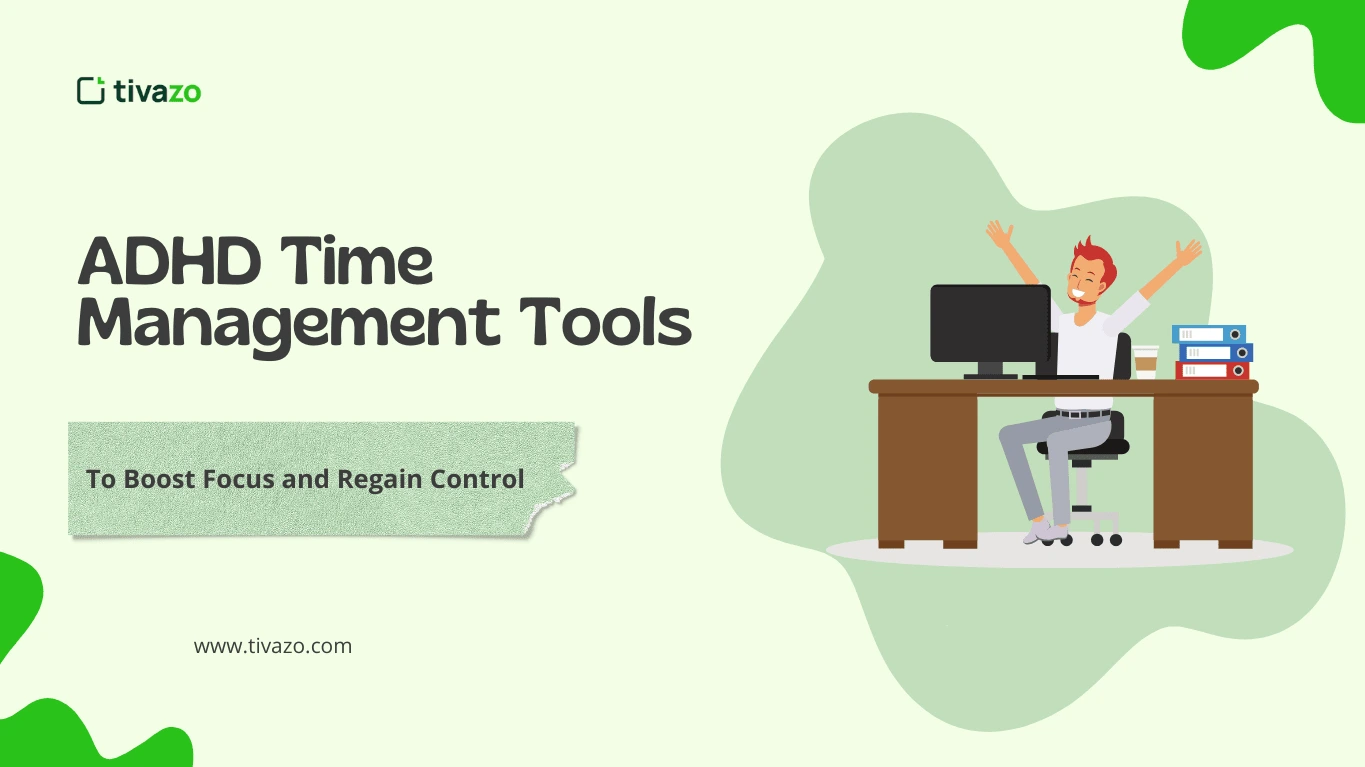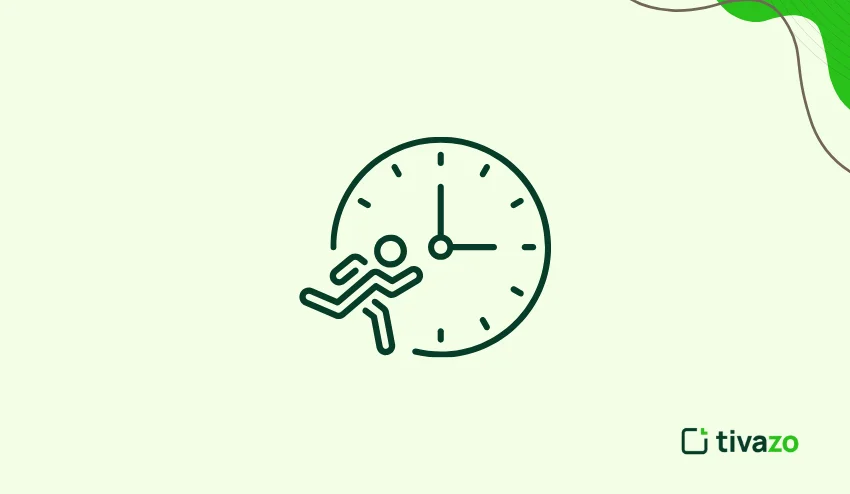The Stephen Covey time management matrix is a productivity tool that is revolutionizing the way you work by allowing you to work smarter, not harder. In this guide, you’ll learn about the Stephen Covey time management matrix and how to use it, as well as incorporate it into your day-to-day workflow, so you spend your time on what truly matters.
You will learn how to utilize it effectively, apply the 7-8-9 rule to prioritize your important tasks, use the 5 Ps to effectively manage your time, and understand the real advantage of shifting your focus from urgent tasks to important tasks to consider your long-term goals. We’ll also compare it in detail with the Eisenhower Matrix so you can determine what productivity tool works best for you.
Key Highlights:
- What is the Stephen Covey time management matrix?
- The Four Quadrants
- How to Work with the Covey Matrix (Step-by-Step)
- The 7-8-9 Rule for Time Management
- The 5 Ps of Time Management
- The Advantages of the Covey Time Management Matrix
- Covey Matrix vs. Eisenhower Matrix
What is the Stephen Covey time management matrix?
The Stephen Covey time management matrix is a straightforward yet powerful two-by-two matrix that categorizes tasks by urgency and importance, helping users prioritize what matters (not simply react to what is the loudest). The matrix originates from The 7 Habits of Highly Effective People – Covey popularized the matrix and was based on Eisenhower’s model.
The matrix’s essence is to help you discern between activities that contribute meaningfully to your long-term goals versus activities that merely take up time without a meaningful return to you. By clarifying your tasks into 4 distinct quadrants, you can see where your attention is going for better choices around how to spend your time, thus allowing you to move from busy to effective.
Most productivity tools are focused on a scheduler or to-do list; the Stephen Covey time management matrix emphasizes intentionality. It’s about addressing urgent matters but striking a balance. The Stephen Covey time management matrix is particularly useful to professionals, leaders, and teams who must juggle various competing priorities and minimize unnecessary frustration and burnout.
When the matrix is consistently applied, not only does it improve productivity, but it can also improve decision-making, reduce stress, increase effectiveness, and ultimately lead to long-term success.
The 4 Quadrants of Stephen Covey Time Management Matrix
1: URGENT & IMPORTANT
- These are tasks that require immediate action, and there will be serious repercussions if you do not act quickly.
- Examples include crises, deadlines of important projects, urgent matters related to clients, emergencies, etc.
- These tasks typically cause you stress and pressure, but there is no way to avoid them occasionally.
- Tip: Act on these tasks as soon as possible, but try and reduce the frequency of them by spending more time in Quadrant 2.
2: NOT URGENT, BUT IMPORTANT
- These are high-value activities that go towards achieving a goal, personal growth, and success (overall).
- Examples include strategic thinking and planning, skill development, networking, preventive health checks, new ideas, etc.
- This is the quadrant of proactive work, and the biggest long-term benefits will arise from these activities.
- Tip: This quadrant should be treated as a priority daily, as it is the best way to reduce the emergencies of Q1, while increasing sustainable productivity.
3: URGENT, BUT NOT IMPORTANT
- These are tasks that appear to be urgent but have very little impact on meaningful goals.
- Examples include interruptions, phone calls, non-essential meeting requests, basic administrative requests, etc.
- These can invariably take on the form of other people’s priorities.
- Tip: Try to delegate, diminish, or create levies to make sure these do not take up your productive time.
4: Not Urgent & Not Important
- Low-value or pure wasting time activities that have little or no benefit.
- Examples: Scrolling on social media for hours, gossiping, binge-watching, and unproductive busy work.
- The more time you spend here, the more opportunities you lose and the less effective you feel.
- Tip: You should eliminate these activities as much as possible and save as much energy as you can for Quadrants 1 and 2.
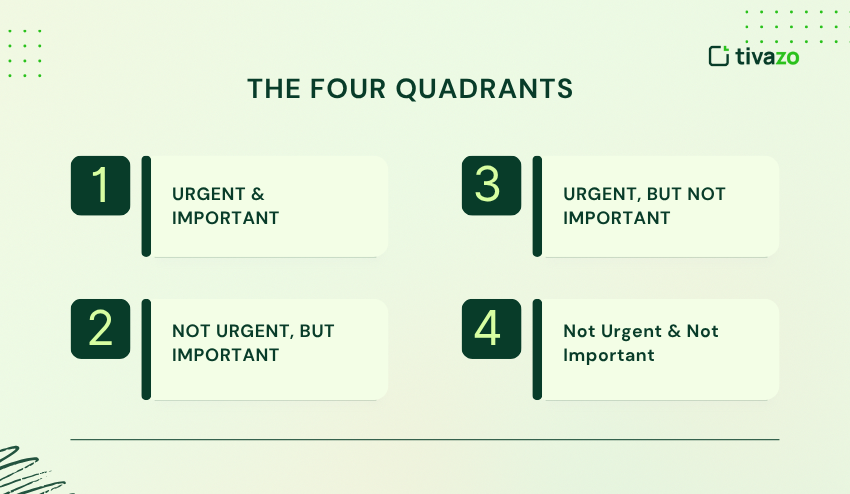
How to Work with the Covey Matrix (Step-by-Step)
1. Write down all your tasks
Start by writing down all of your tasks, projects, and responsibilities without editing or judgment, just to allow you to remember every possible task when you input work into the Stephen Covey time management matrix.
2. Evaluate all tasks for urgency and importance
For each task, ask yourself the simple questions, “Is this urgent?” and “Is this important?” This allows you to stop and determine the urgency and importance of your priorities within your week.
3. Put the tasks into the four quadrants
After identifying urgency and importance, plot the tasks based on where you will input them into the matrix.
4. Prioritize your actions
- Do the tasks in Q1 right away, in order to take care of the crises and deadlines.
- Spend the most time on tasks in Q2 to work on strategic, long-term goals.
- Delegate or minimize tasks in quadrant three to keep them from taking away from your priorities.
- Get rid of tasks in quadrant four to eliminate time wasters.
5. Review weekly
It is important to use your matrix frequently, to ensure you are always working with and staying focused on Q2 in the framework of the Stephen Covey time management matrix for longer and sustainable productivity without stress.
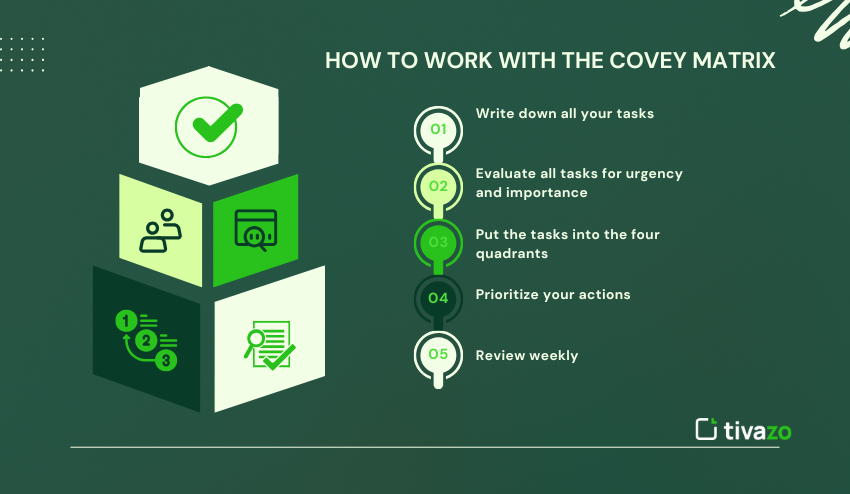
The Advantages of the Covey Time Management Matrix
| Benefit | Explanation |
| Increase productivity | Regularly focus on actions that will make the largest difference and reduce negative overwhelm. |
| Better planning habits | Take control of your planning system and evolve from a reactive system to a proactive routine. |
| Work-life balance | Focus your time on the things that truly matter in your work and personal life. |
| Self-awareness | Make your use of time visible across all four quadrants, and recalibrate your focus. |
In summary, using the Stephen Covey time management matrix to keep you focused on the most important tasks can help you prioritize, relieve stress, and increase productivity. Importantly, because it requires you to focus on the most important tasks, it helps you develop ways to be a more effective planner, helping you to improve your work-life balance, and ultimately leading to success by empowering you to manage your time intentionally and make smarter decisions.
How to Implement the Covey Time Management Matrix
One of the best time management can is the Stephen Covey Time Management Matrix to enhance focus, productivity, and clarity. This time management grid assists you in assessing work according to urgency and importance so as to build additional time management competence and do what matters.
1. Understand the Four Quadrants
Before you begin, familiarize yourself with the four quadrants of the Covey Time Management Matrix:
- Quadrant I: Urgent and Important
- Quadrant II: Not Urgent but Important
- Quadrant III: Urgent but Not Important
- Quadrant IV: Not Urgent and Not Important
Understanding these categories is essential for mastering Stephen Covey time management principles.
2. List All Your Tasks
List all the things that you have to manage- work, personal, and long-term goals, and daily chores. This provides you with a clear picture of the implementation of the time management matrix.
3. Evaluate Each Task by Urgency and Importance
Assign each task to its appropriate quadrant based on Stephen Covey’s framework.
- Ask: Is this task important to my goals?
- Ask: Does it require immediate attention?
This step is crucial for improving your overall time management approach.
4. Prioritize Quadrant II Activities
Quadrant II (Important but Not Urgent) is where long-term success occurs- Planning, learning, relationship-building, strategic thinking, and health.
This concentration is one of the most effective time management strategies that Stephen Covey trains.
5. Reduce or Delegate Quadrant III and IV Tasks
Activities in Quadrant III (Urgent but Not Important) are to be delegated, streamlined, or minimized.
Quadrant IV (Not Urgent and Not Important) tasks are to be minimised or removed completely. This sets free high-value work.
6. Use a Daily or Weekly Planning System
Look at your matrix on a regular basis, either daily or weekly, to change tasks and keep pace with your goals.
The habit will enable you to develop time management skills and ensure that you make steady progress.
7. Take Action and Review Your Progress
Begin to implement according to your priorities quadrants. Look back at the end of every day or week and see what went well and what did not, and then modify your Stephen Covey time management strategy.
The 7-8-9 Rule for Time Management
The 7-8-9 rule is a simple and effective way to prioritize tasks within the **Stephen Covey time management matrix** and assigns a number to each quadrant to help you decide where to allocate your time and energy.
7 Quadrant 1 (Urgent & Important) – These tasks require immediate attention. Emergencies, crises, and time-sensitive tasks would fit in here, and while you can’t avoid all of the urgencies over your career, the longer you spend in Quadrant 1, the more stress and burnout you will face.
8 Quadrant 2 (Not Urgent but Important) – Proactive impact tasks that move you to your long-term goals (planning, learning, building relationships, preventive). This would be the most valuable quadrant for sustainable success.
9 Quadrants 3 & 4 (Low-Priority Distractions) – Quadrant 3 is urgent distractions that are unimportant, and Quadrant 4 is where time is completely wasted.
The 7-8-9 rule emphasizes your efforts at 8 (Quadrant 2), so if you look after 8, you can reduce your 7 urgent crises and appreciate distraction at 9 even less. As you practice this way of thinking and acting, the **Stephen Covey time management matrix can be helpful for your daily decisions. More focus equals greater productivity.
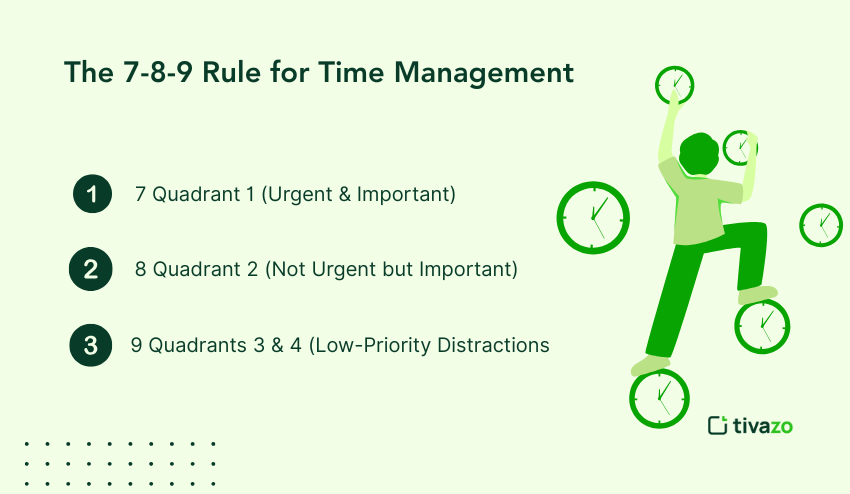
The 5 Ps of Time Management
Combining the 5 Ps with Stephen Covey time management matrix creates an impactful approach for managing your time and producing results. Here is a detailed discussion of each “P”:
1. Purpose
Your purpose is vital to effective time management. Your purpose is about understanding and clarifying your long-term “why” — your values, vision, and goals that guide your actions. When you have a clear purpose, you can better identify your important tasks and where to spend your limited time and energy.
As mentioned earlier, the Stephen Covey time management matrix helps you keep your daily activities aligned with your purpose. Ideally, Quadrant 2 (important, not urgent) activities should make up the majority of your time. It can be argued that Quadrant 2 tasks usually help you get closer to your goal(s) or purpose, while Quadrant 1 (important, urgent) tasks, while needed, sometimes just need to be dealt with (Heller, 2018).
2. Planning
Planning means you are designing your schedule in advance instead of being reactive to demands. In terms of the Stephen Covey time management matrix, planning involves distinguishing and reserving time for the Quadrant 2 (important, not urgent) activities like goal setting, learning about a topic, or relationship building. When you schedule these activities ahead of time, you are less likely to find yourself with too many pressing quadrant 1 crises and can stay nearer to productive and purposeful progress.
3. Prioritization
The essence of the Stephen Covey time management matrix is prioritization: telling what’s urgent from important. Prioritization means making a deliberate choice to invest our time and efforts into pursuits that create the greatest impact (where we live mostly in Quadrant 2). Prioritizing avoids the pitfalls of getting drawn into less important Quadrant 3 / 4 distractions disguised as urgent.
4. Productivity
Productivity is not merely about doing more; it’s about getting the most output from deliberate effort. By focusing your energy on the Quadrant 2 tasks, you will work smarter and create an opportunity to improve intentional, quality work and efficient production while relieving stress associated with the lack of productivity. The Stephen Covey time management matrix empowers us to leverage our best energy to thoughtfully undertake strategic work that has long-term returns to us personally and professionally.
5. Prevention
Prevention is a form of totality that actively blocks the propagation of future problems. Allocating time for Quadrant 2 pursuits, including planning, deliberate training, or relationship investment, is a wise use of time and allows for mitigating risk from foreseeable emergencies or crises that will inevitably arise from limited access to Quadrant 1. The Stephen Covey time management matrix endorses this prevention focus and proactively eliminates future imposition on intentional, focused, effective effort, decreasing the number and intensity of our urgent challenges and creating a more defined, sustainable pace of work.
In concert, these 5 Ps coupled with Stephen Covey time management matrix allow us to strategically use our limited time effectively, focus, and productivity.
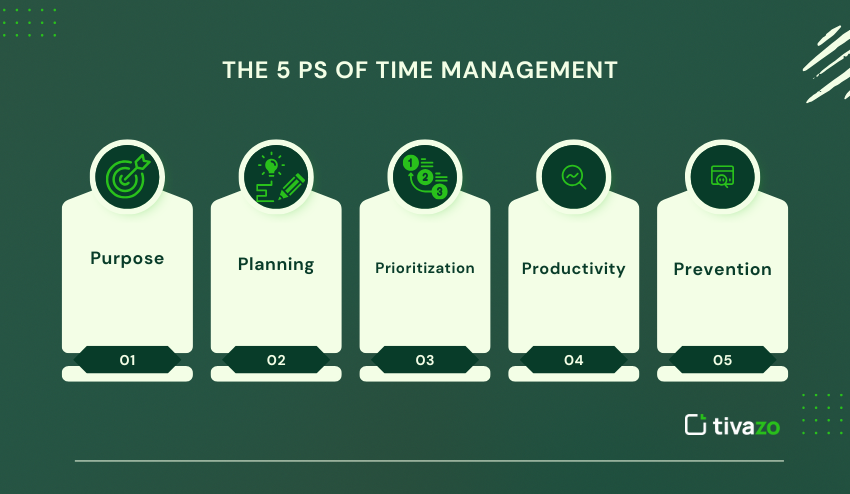
Covey Matrix vs. Eisenhower Matrix
Both matrices categorize tasks based on urgency and importance. However, the Covey and Eisenhower Matrices have different purposes and applications.
Eisenhower Matrix:
- Primarily a tactical, quick decision-making tool.
- Helps determine whether to do, schedule, delegate, or delete tasks.
- Ideal for managing daily task lists.
- Decisions are about taking personal action quickly.
Stephen Covey Time Management Matrix:
- Focuses on longer-term, involved value-based planning.
- Emphasis in particular on Quadrant 2 activities that include planning, relationship building, and an area for personal growth.
- Includes time for reflection, intentionally developing habits, and positively aligning with life priorities.
Helps minimize urgent crises (Quadrant 1) by investing time in important but not urgent activities that will reduce future emergencies.- Assists you in sustaining productivity, balance, and fulfillment over time.
Here’s a key difference:
- The Eisenhower Matrix is a matrix for quickly prioritizing user tasks.
- The Covey matrix is a holistic system for fully transforming your management of time and energy for future behavior using previous patterns for continued long-term learning and success.
Using Tivazo to Apply the Stephen Covey Time Management Matrix in Daily Life
The Stephen Covey Time Management Matrix is also easier to implement in everyday life with the help of Tivazo, which provides you with a clear understanding of how you use your time. Its tracking capabilities make it easy to become a power user, better your time management abilities, and locate activities in all four quadrants of the time management matrix, as well as concentrate on high-value activities in Quadrant II.
Using productivity reports provided by Tivazo, you are able to improve your time management in general, get rid of distractions that are of low priority, and promote the main tenets of Stephen Covey’s time management. This can assist you in ensuring that you implement good time management and are within what is really important to you every day.
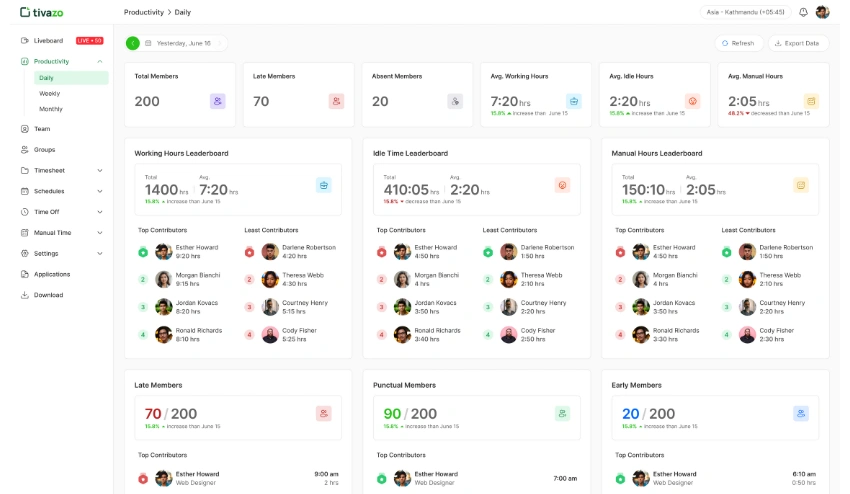
Conclusion
The Stephen Covey time management matrix, created for time management, is a very versatile tool that helps you prioritize the urgency and importance of tasks and make better, smarter decisions about working on what ultimately matters. Understanding the four quadrants, the 7-8-9 Rule, and inter-process with the 5 P’s of time management is sure to help you increase productivity, allow for stress-less time management, and ultimately achieve long-term goals.
The biggest distinction between the Eisenhower Matrix and Covey’s is that the latter supports people in making their plans for and engaging in their growth, and thus is less about task sorting and more about sustainable productivity. Using this matrix format regularly is going to create deliberate time management for better decision-making and ultimately a satisfying and meaningful life.
